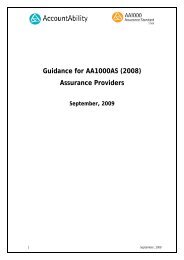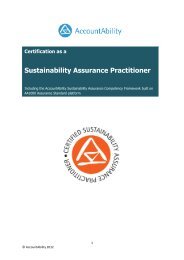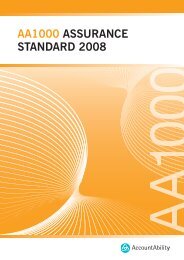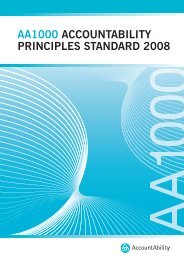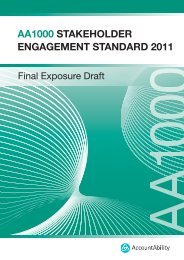The Stakeholder Engagement Manual Volume 2 - AccountAbility
The Stakeholder Engagement Manual Volume 2 - AccountAbility
The Stakeholder Engagement Manual Volume 2 - AccountAbility
You also want an ePaper? Increase the reach of your titles
YUMPU automatically turns print PDFs into web optimized ePapers that Google loves.
Strengthen Capacities for <strong>Engagement</strong><br />
P11: STRENGTHENING YOUR COMPANY’S ABILITY TO RESPOND<br />
Strengthening Enablers for Successful Response<br />
Enabler Ways of Strengthening the Enabler<br />
Board and management<br />
commitment to issue<br />
Top management fully aware of the<br />
issue, the required resources, and<br />
understand linkages with business<br />
strategy and objectives, as well as the<br />
opportunities and the risks associated<br />
with engagement.<br />
Agreed policies or procedures<br />
regarding the issue<br />
Policies developed through dialogues<br />
involving those responsible for<br />
implementation, those infl uenced<br />
by them, and those responsible for<br />
allocating the required resources for their<br />
implementation.<br />
Current engagement activities<br />
regarding the issue<br />
<strong>Engagement</strong> activities aligned with the<br />
governance and management processes<br />
that direct the business.<br />
Performance indicators and targets<br />
regarding the issue<br />
Performance indicators, measurements<br />
and targets informed by stakeholder<br />
dialogue.<br />
Internal responsibility and competency<br />
to address the issue<br />
Staff involved have the required<br />
skills, personal characteristics<br />
and competencies to engage with<br />
stakeholders and address this issue.<br />
Review and learning processes in regards<br />
to the issue<br />
Processes in place to ensure review<br />
and learning to innovate and adapt<br />
organisational policy and processes.<br />
Senior level champions for specifi c issues can drive high level responsiveness.<br />
Internal allies can be very helpful in taking specifi c issues to top-level management,<br />
can be found across the company, for example risk managers, investor relations, the<br />
marketing department or quality management.<br />
Executive remuneration can be linked with issue-specifi c metrics.<br />
Key budget holders need to be involved in a conversation about necessary budgets<br />
and the availability of fi nancial resources. <strong>The</strong>ir understanding of these issues is<br />
crucial to their buy-in, and for securing the necessary resources.<br />
Board and management shall also be encouraged to take a leadership role<br />
in championing the issue. <strong>The</strong>y need to be involved in order to understand their<br />
responsibility for leading the process and driving the associated vision, mission,<br />
strategic considerations and developing a responsive internal culture and values.<br />
Not all internal groups will be involved in the development of a fi rst policy draft, but<br />
should be involved in shaping the fi nal policy through, for example, stakeholder<br />
advisory panels or consultations .<br />
Corporate responsibility standards, like the ones mentioned in the table on p57.<br />
(where to look for further learning) or those developed by other companies can<br />
provide a model for policies, which draws on or has already been legitimised through<br />
stakeholder involvement.<br />
<strong>The</strong> timing of stakeholder interactions should allow them to feed into internal<br />
reporting, budgeting and management cycles.<br />
Governance and management processes should include specifi c quality control<br />
mechanisms to control the quality of the organisational response.<br />
Initial internal discussion about indicators and targets especially considered within<br />
the context of other business objectives and measurement systems can form a basis<br />
for discussion with other internal and external stakeholders.<br />
Integration of relevant skills into recruitment policies, job-requirements and<br />
performance-appraisals is essential. This should include both individuals with<br />
signifi cant contact with external stakeholders as well as for managers with signifi cant<br />
infl uence over internal stakeholders.<br />
A holistic approach to reviewing the whole engagement process is set out in Stage 5,<br />
but on a smaller scale learning circles, discussion forums as well as learning<br />
networks within or between different companies or stakeholders are a useful<br />
mechanism.



